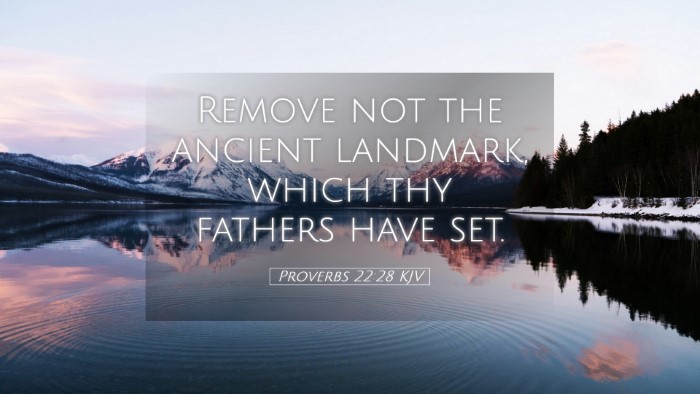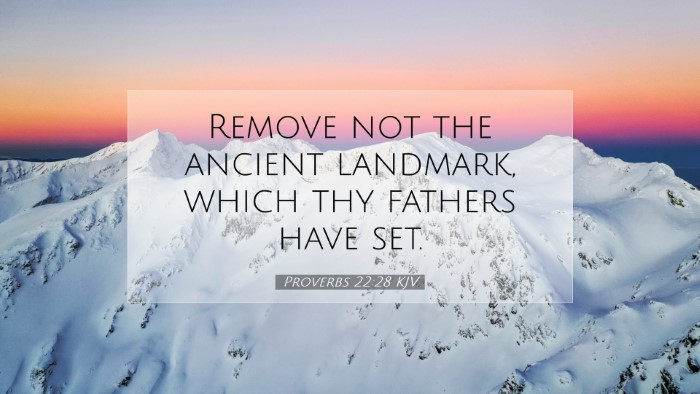Commentary on Proverbs 22:28
Verse: "Remove not the ancient landmark, which thy fathers have set."
Introduction
Proverbs 22:28 presents a profound principle rooted in the preservation of heritage and the respect for established boundaries. This verse serves as a guiding admonition concerning the importance of maintaining traditional values and practices that have been passed down through generations. By exploring insights from respected biblical commentators, we can gain a deeper understanding of the implications of this instruction within a spiritual and societal context.
Interpretation and Analysis
The verse’s primary instruction is to not remove the landmark, which serves as a metaphor for the principles, values, and traditions that form the foundation of society. In ancient Israel, physical landmarks were literal boundaries marking land ownership, which signified stability and order within the community.
Each commentator offers a layer of depth to this understanding:
-
Matthew Henry:
In his commentary, Henry emphasizes the significance of these landmarks as the embodiment of moral and spiritual truths. He warns against the tendency to disregard or alter divine ordinances that have stood the test of time. The ancient boundaries are not just physical; they represent the tradition and instruction given by God, which should be honored and maintained.
-
Albert Barnes:
Barnes adds to the commentary by reflecting on the consequences of removing such landmarks. He argues that doing so leads to confusion and moral decay. When individuals or societies dismiss long-standing truths, they forfeit the wisdom that has guided their predecessors. Barnes calls for vigilance in maintaining these inherited truths as essential for spiritual and communal health.
-
Adam Clarke:
Clarke highlights the social implications of the proverb. He discusses how landmarks serve to protect the property rights that lay at the heart of a functioning society. By urging against their removal, the wise sage underscores the necessity of stability and respect for one another’s rights in order to foster a peaceful society.
Theological Implications
From a theological perspective, Proverbs 22:28 invites reflection on God’s unchanging nature and the guidelines He has provided through Scripture. The landmarks symbolize God’s unchanging laws that govern moral behavior and societal interactions.
This can be likened to a covenant relationship, wherein God establishes boundaries for His people to ensure spiritual well-being. By adhering to these divine landmarks, believers affirm their commitment to living in accordance with God’s will.
Practical Applications
The practical applications of this verse are manifold, particularly for leaders and educators within the church:
-
Preservation of Truth:
Church leaders are called to uphold the truth of Scripture and the doctrinal teachings that have shaped faith communities throughout history. This preservation prevents the dilution of the Gospel message.
-
Guidance for the Next Generation:
As pastors and teachers, there is a responsibility to impart the wisdom of past generations to young believers. They must ensure that the boundaries of faith, morals, and ethics are well-defined and respected.
-
Countering Cultural Changes:
In a rapidly changing world, there is a tendency to shift or redefine moral landmarks. It is incumbent upon Christian leaders to thoughtfully resist these pressures and reaffirm the unchanging truth of God's Word.
Cultural Context
Understanding the cultural context of ancient Israel enhances appreciation for this verse. Landmarks were vital for agricultural societies, and shifting them was not merely an injustice but a direct challenge to communal stability. Such actions could lead to disputes and social unrest. This proverb thus resonates with a community-oriented approach where individuals recognized the importance of maintaining order for the welfare of all.
Conclusion
Proverbs 22:28 teaches a timeless lesson about the importance of preserving the ancient landmarks established by our forebears. The discourse surrounding this verse challenges contemporary believers to think critically about what they uphold in their lives and communities.
By integrating the wisdom of commentators like Henry, Barnes, and Clarke, we are reminded that respecting these boundaries is crucial to living a life aligned with God’s intentions for His people. As pastors, theologians, and students of the Word, we are called to guard these landmarks diligently, ensuring that the faith and values bequeathed to us continue to guide future generations.


